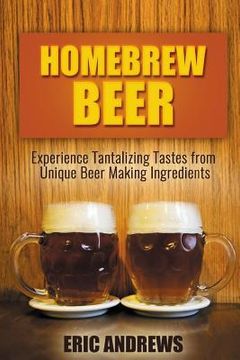Homebrew Beer: Experience Tantalizing Tastes from Unique Beer Making Ingredients (in English)
Synopsis "Homebrew Beer: Experience Tantalizing Tastes from Unique Beer Making Ingredients (in English)"
Do You Want a Source of FREE Beer for the Rest of Your Life? What About Wine or Soda? If you answered "Yes" to These Questions, Then This Book Is for You. Homebrew Beer begins with the author's personal recollections of his journey about learning how to make beer and leads into his current experiments with ginger, potatoes, rice, and herbs. Ginger appears to be an extremely versatile ingredient in beer making. The author shows you how to use it in beer and wine and mead and ale. You're also given specific information regarding how to control the fermentation process for both alcoholic and non-alcoholic brews. Other information about Homebrew Beer includes its categories -- cooking, food & wine/beer and reference -- and its tags: beer making book, beer brewing recipes, beer making supplies, beer fermentation, beer tasting, beer ingredients, beer recipes Here is a short excerpt from inside the book to give you a taste of how this author writes . . . "When discussing the possibilities presented by the concept of a "Ginger Ale", there are many directions toward which a home-brewer could depart. The question of wild fermentation vs. inoculation by brewer's yeast comes to mind. Following this decision there are questions as to how the yeasts will be fed, what the main components of the beer will be, whether or not there will be any adjuncts, whether or not it will be alcoholic, and following the fermentation - what other uses exist for a lacto-fermented ginger culture? All of these questions are possible points of divergence for an experimenter, and many recipes exist for you to choose from. We will begin discussion about the creation of what is called a "Ginger Bug". The issue here is that it will typically be an option for you to purchase packaged yeasts if that is the route that you would like to go - some recipes even suggest that you inoculate the decoction with whey. From what I have read, whey is fermented by microbes that are especially attuned to processing lactose [sugar from dairy], and there are other microbes that are more suited to processing sucrose, fructose, or glucose [plant sugars]. I was taken by the idea that all of the yeast I would need could be encouraged to grow based on the shavings of an organic ginger peel - so that is the route of experimentation that I chose to take. When selecting the ginger for your Ginger Bug, it is important that you purchase organic ginger. Not only is this ginger free from pesticides, but when it is imported, it is not radiated, unlike conventional ginger. The process of irradiation destroys the bacteria that we are counting on to feed and proliferate within the culture to come. I've read that any rhizome will do, and even some roots -- such as dandelion and burdock. Seeing as how two of the major flavoring rhizomes I can think of are of tropical origin: turmeric, ginger, you may be inclined to experiment with the dandelion root in your backyard for your next roots beer. The important thing is that the root is healthy, clean, having desirable flavor or qualities, and has a population of microbes living on its skin. The next step is to obtain filtered water. The importance of the filtration is due to the fact that much of our water is chlorinated and the chlorination would prevent bacterial growth. With lacto-fermentation, we are attempting to encourage bacterial growth. Once you have a small amount of filtered water, the next ingredients you will need are organic ginger, and raw sugar, agave, or molasses. I have also heard of honey being fed to the Ginger Bug, and I have heard of honey as containing anti-microbial properties, and therefore retarding population growth. The biggest counter example I can provide to the anti-honey argument is that Mead is traditionally made from honey and water, and though it takes a while to ferment, the yeasts are obviously able to process it eventually or mead as an alcohol would have never existed. In order to start a ginger bug. .

